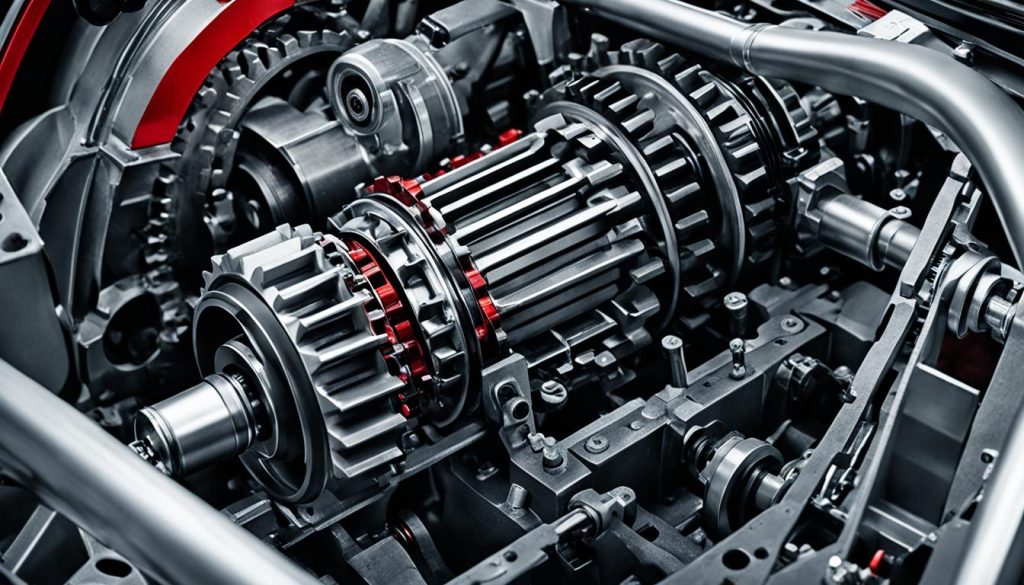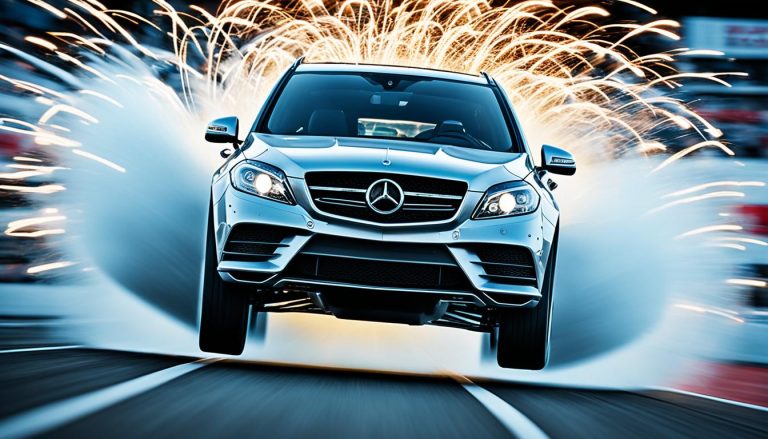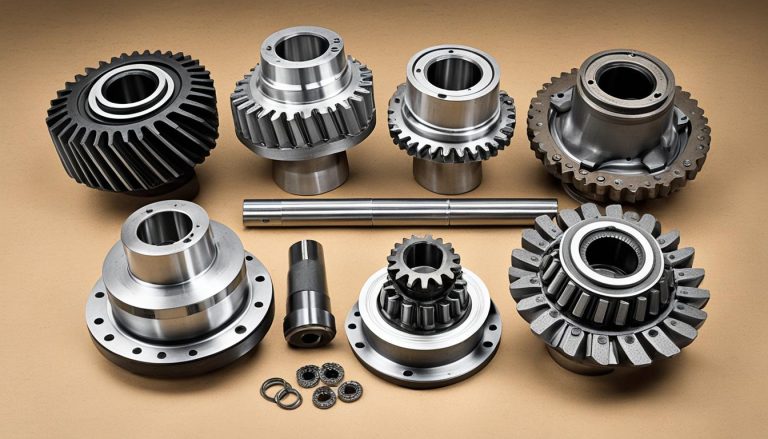Unlock Trails or Track Stability: Locking Diff vs Non-Limited Slip
If you’re looking to up your vehicle’s performance, understanding the type of rear differential you have is crucial. Whether you’re a weekend warrior taking on backcountry trails or someone who needs confident handling on slick, rainy streets, the debate of electronic locking rear differential vs non limited slip is front and center. Your driving habits and the conditions you frequently encounter will steer you toward the system that best suits your needs.
For those of you sticking mainly to the tarmac with an occasional venture off the beaten path, a non limited slip differential can often do the trick. It offers a gentle, cost-effective solution to everyday driving. However, when the going gets tough, and you find yourself facing rugged terrain and uneven ground, the pinpoint traction control of an electronic locking rear differential may be your ticket to overcoming obstacles with ease.
Let’s navigate the differences between these systems to help you decide the best match for your adventures on or off the road, keeping in mind a rear differential comparison and the locking differential vs limited slip capabilities.
Key Takeaways
- Off-Road or On-Road: Non limited slip differentials are ideal for consistent street driving, while electronic locking rear differentials excel in challenging off-road conditions.
- Personal Preference: Evaluate your driving style to choose a differential that corresponds with how you use your vehicle.
- Modern Vehicle Compatibility: Ensure the differential you select works harmoniously with your vehicle’s ABS and stability control systems.
- Budget Constraints: Factor in cost, as different systems come with varying price tags and installation complexity.
- Balancing Act: Lockers provide uncompromised traction but may affect on-road behavior, where limited-slip diffs offer a smoother operation.
- Tech Specs: Engagement methods for differentials range from switches and air pressure to cable shifters, offering varying levels of control.
Determining the Right Differential for Your Vehicle
As a dedicated driver, your vehicle’s performance is paramount. The heart of traction control, the differential, varies significantly from model to model, each type serving a specific purpose. Whether you’re navigating steep, rocky inclines or commuting over sleek highways, understanding the differences between locking and limited slip differentials is crucial in choosing the right fit for your drive.
Understanding Your Driving Needs and Conditions
If your adventures regularly lead you off the beaten path, you’ll benefit from knowing the non limited slip differential features that facilitate standard navigation, contrasting deeply with the rugged electronic locking differential benefits employed for more challenging terrains.
Compatibility with Modern Stability Control Systems
Newer generations of 4×4 vehicles come equipped with sophisticated ABS and stability control systems, designed to work harmoniously with advanced differential types. It’s essential to ensure that your choice of differential not only fulfills your adventure needs but also integrates flawlessly with your vehicle’s electronic systems.
Types of Differential Engagement Methods
The method of engagement is a prominent feature among differentials, impacting usability and response on various surfaces. Mechanical lockers, manual locking hubs, and electronically controlled systems each offer unique operational advantages to consider.
Budget Considerations for Differential Upgrades
While contemplating the functionality you seek in a differential, there’s no ignoring the financial side of the decision. Differential types cover a spectrum of price points, from the more economical drop-in lockers to the pricier full-case units designed for severe off-road use.
| Differential Type | Traction | Compatibility | Cost |
|---|---|---|---|
| Locking Differential | Maximized for tough terrains | Select models with stability control integration | Higher investment |
| Limited Slip Differential | Improved traction over non-limited | Widespread vehicle compatibility | Moderate |
| Non Limited Slip Differential | Standard performance | Common in most vehicles | Cost-efficient |
| Electronic Locking Differential | On-demand maximum grip | Selectively compatible with modern systems | High-end price bracket |
Electronic Locking Rear Differential vs Non Limited Slip
When you’re exploring the capabilities of your vehicle, understanding the differences between an electronic locking rear differential and a non limited slip differential is crucial. The two systems offer unique features that can dramatically affect your driving experience. Let’s delve into the key distinctions that separate these two types of differentials and see how they can influence your vehicle’s performance under different circumstances.
The advantages of an electronic locking differential lie in its ability to provide undivided power to both wheels on the same axle. This mechanism enhances your vehicle’s traction, especially when one tire is off the ground or on slippery surfaces. It’s a game-changer in off-road conditions, activating with the flip of a switch to lock the differential, ensuring that both wheels spin at the same rate and you stay moving even in the toughest terrains.
With an electronic locking rear differential, you’re not just driving; you’re conquering landscapes.
In contrast, non limited slip features are favored for everyday street driving. This kind of differential — often an open differential — effortlessly manages the speed variance between your wheels during turns. This contributes to a smooth ride and is more fuel-efficient, making it a cost-effective option. However, when you’re facing low-traction scenarios, like a slippery boat ramp or a snowy road, the non limited slip might not offer the grip you need to power through.
To vividly illustrate their functionalities, here’s a comparative overview:
| Feature | Electronic Locking Rear Differential | Non Limited Slip |
|---|---|---|
| Engagement | Driver-activated (On-demand locking) | Automatic (Varies with conditions) |
| Traction | Excellent in off-road conditions | Optimal for normal on-road use |
| Fuel Efficiency | Less focus on fuel economy | More fuel-efficient on highways |
| Cost-Efficiency | Potentially higher upfront cost | Generally lower cost and maintenance |
| Best Used For | Rugged terrains, rock crawling | Commuting, highway driving |
Now you have a clearer understanding of the electronic locking rear differential vs non limited slip. While an electronic locker could be the key to your next off-road adventure, the non limited slip maintains its reputation as the reliable daily driver’s choice. Weighing their distinct advantages against your driving needs will ensure you make the best decision for your journey on or off the beaten path.

The Mechanics Behind Differential Types
As a vehicle enthusiast, you might wonder about the technical details that distinguish differential types under the chassis of your ride. It’s a pivotal point of knowledge, especially when debating locking differential vs limited slip —each with their own merits in the realms of driving performance and control.

The baseline open differential is nearly universal, providing the essential function of allowing differences in wheel speed, which is particularly noticeable when turning. Contrast that with the mechanical locking differential, which ensures both wheels on an axle spin at the same rate, thus avoiding one wheel spinning free if the other loses grip.
On the other side of the spectrum lies the clutch disc limited slip differential, an ingenious mechanical solution that employs a series of clutch plates to manage torque transfer. When one wheel starts spinning excessively, the clutch pack engages, redistributing power to the wheel with more traction, thus maintaining momentum and control.
| Type of Differential | Primary Function | Best For |
|---|---|---|
| Open Differential | Allows wheels to rotate at different speeds | Regular on-road driving |
| Mechanical Locking Differential | Locks axle output to equalize wheel speed | Off-road and challenging conditions |
| Clutch Disc Limited Slip | Distributes torque to the gripping wheel via clutch packs | Performance vehicles and driving with occasional slipping |
Understanding these mechanics not only informs your choice but also builds a greater appreciation for the innovation behind vehicle performance. Whether you choose a rugged mechanical locking differential for your off-road adventures or a smooth-operating clutch disc limited slip for spirited on-asphalt excursions, you’re now empowered with the knowledge to select the perfect component for your driving needs.
Advantages of an Electronic Locking Differential
When off-roading enthusiasts seek out modifications to enhance their vehicle’s performance, one consideration at the forefront is the electronic locking differential benefits. Unlike the traditional non limited slip comparison, this technology provides distinct advantages for demanding terrain. Here’s how an electronic locking differential could be the game-changer for your adventures.
Selectability and Traction Control
Imagine having the power to switch your vehicle’s differential to adapt to any terrain instantly. With the selectability feature of an electronic locking differential, that’s exactly what you can do. It’s the ultimate convenience for drivers who transition between on-road drives and rigorous off-road challenges, optimizing traction when you need it most. This is a crucial edge in the locking differential vs limited slip debate, offering unparalleled control over your vehicle’s capabilities.

Durability and Strength for Tough Trails
As you push your vehicle to its limits on rocky paths, durability becomes non-negotiable. Electronic lockers are engineered for resilience, built to withstand the kind of circumstances that would challenge lesser components. They’re adept at not just surviving but excelling when tackling the unyielding backcountry, evidence of the superior toughness an electronic locking differential provides.
Handling Quirks on the Road
However, it’s not all about off-road might. On the highway, there are some nuances to consider. Vehicles equipped with certain types of differentials may experience increased tire wear or differences in handling due to how the locking mechanism affects turn dynamics. Yet, these quirks are often offset by the substantial performance enhancement where it counts: on rugged trails and during critical off-road maneuvers.
Navigating the Features of Non-Limited Slip Differentials
When you dive into the dynamics of your vehicle, understanding the inner workings of the non-limited slip differential can save you from potential traction pitfalls. This differential type, comprising predominantly open differentials, arrives as the factory standard due to its harmonious operation in typical driving conditions. Yet, when you match it against its counterpart, the electronic locking rear differential, disparities in performance become apparent, particularly in challenging environments.
Street Performance and Mild Off-Road Capabilities
The non limited slip differential features shine on the asphalt where comfort and control are paramount. This differential ensures smooth cornering by allowing wheels to rotate at different speeds, hence preventing unnecessary strain on the drivetrain. For your light off-road excursions, it provides a mild level of competence, ensuring you can enjoy unpaved paths with confidence, albeit with caution during more intense conditions.
Understanding the Factory Standard in Most Vehicles
Much like the trusted backbone in a classic novel, the non-limited slip differential supports the narrative of everyday driving with reliability. It’s the unsung hero found under the hood of most vehicles, catapulting you into seamless drives with its unfussed demeanor. This component skillfully directs power to the wheel with less grip when negotiating regular road bends, a subtle dance that maintains vehicular poise and economy.
The Impact of Wear and Required Maintenance
Although durable, your non-limited slip differential isn’t immune to the trials of time and terrain. Vigilant upkeep is necessary to ensure longevity and sustained performance. Keep an eye out for signs of wear in the clutch discs and remain proactive with oil condition to circumvent issues that could lead to compromised grip. Periodic maintenance and the use of friction modifiers when needed can help mitigate wear and maintain a responsive and efficient drive.
FAQ
What are the key differences between an electronic locking rear differential versus a non-limited slip differential?
An electronic locking rear differential can lock both wheels on an axle together, offering full traction when needed, particularly useful in off-road conditions. A non-limited slip differential, typically an open differential, is better for street driving, allowing for different wheel speeds during turns and providing better fuel efficiency but it can struggle in low-traction scenarios.
How do I decide which differential is right for my vehicle?
Consider your main driving conditions, such as frequent off-roading or primary street driving. Also, keep in mind the compatibility with your vehicle’s ABS and stability control systems, the type of engagement method you prefer for a differential, and your budget for upgrades and maintenance.
What are the engagement methods for differentials and how do they differ?
Engagement methods for differentials include 12-volt switches for electronic lockers, air pressure systems, and manual cable shifters. Selectable lockers offer versatility, while gear-driven and clutch-type limited slips provide smooth performance for conditions like snow and ice.
Why might I choose an electronic locking differential over other types?
Electronic locking differentials offer the benefits of selectability, allowing you to switch between locked and open states depending on the driving conditions. They provide unmatched traction in off-road situations and are built to handle tough terrain, but they may have handling quirks such as increased tire wear on the road.
What are the advantages of a non-limited slip differential?
Non-limited slip differentials are great for everyday road performance and are typically more economical. They operate seamlessly and are the standard in most vehicles. Their maintenance is relatively straightforward, involving checks on the clutch disc and oil levels, and may occasionally require friction modifiers.
Can an electronic locking rear differential benefit on-road driving conditions as well as off-road?
Yes, the selectability feature of an electronic locking differential allows you to benefit from the superior grip during off-road adventures, while also having the option to switch back to typical open differential operation for regular on-road driving conditions, offering a balanced driving experience.
Are there any handling or wear issues associated with non-limited slip differentials?
While non-limited slip differentials generally offer smooth handling, in low-traction conditions, they may not perform as well as locking or limited-slip differentials. Over time, the clutch discs within these systems can wear, leading to less effective torque transfer and may require adding friction modifiers to the differential oil.






